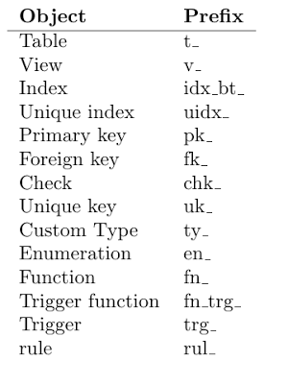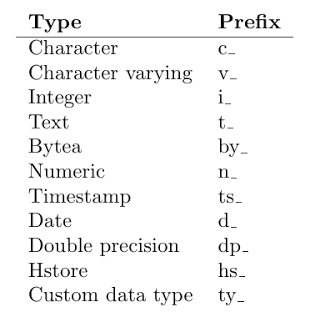Nuts and bolts part 4 - naming conventions and editors
Named identifiers
Writing and debugging the SQL is not simple and a little bit of clarity becomes a massive help. Adding a prefix to the identifiers gives to the SQL developer a great knowledge about the database schema.
This naming convention makes clear the difference between tables which are physical entities, and the views which are names for saved SQL statement.
Adopting a similar approach for the column names makes the data type immediately recognisable.
Both naming schemas prevent the risk of having reserved keywords used for the identifier’s name.
The drawback is if the object type changes. For example if a table becomes a view the name should reflect the change. In an ideal world this shouldn’t happen. In the real life building a solid schema design reduces greatly this kind of issues. However, changing the data type, in particular if dealing with big tables, is more complicated than renaming a field and, after all is a DBA problem.
The editor
Unlikely many commercial RDBMS PostgreSQL, ships only with the command
line client psql. There is a good quantity of third party clients with
good support for the database features and a good connectivity layer. An
exhaustive list of those clients can be found on the PostgreSQL wiki
https://wiki.postgresql.org/wiki/Community_Guide_to_PostgreSQL_GUI_Tools.
Is difficult to say which editor is the best. When I started learning
PostgreSQL the only tool available was PgAdmin 2 and phpPgAdmin. I
decided for the former and then I switched to the newer PgAdmin 3 which
added a powerful editor and multi platform support. In the years I
tested some of the other clients like TOra, SQL workbench and SQL
Maestro and I never found the same confidence and ease of usage like
PgAdmin 3. Whether is the tool of your choice this should have the
following features.
libpq connector
One of the reasons I do not like SQL workbench is the JDBC connector. Writing and testing the SQL code is a quick process. Write the statement, test it, then change it, the test it again and so on. The client response in this method is absolutely important. The libpq connector have virtually no lag, except the disk/network bandwidth.
Removal of the Byte Order Mark (BOM)
The BOM is a marker set in the UTF8 files to determine the byte order. The client psql manages the presence but for some reasons it can fail with an error when running sql scripts with this marker. In PgAdmin 3 is possible to disable the BOM when saving the files.



